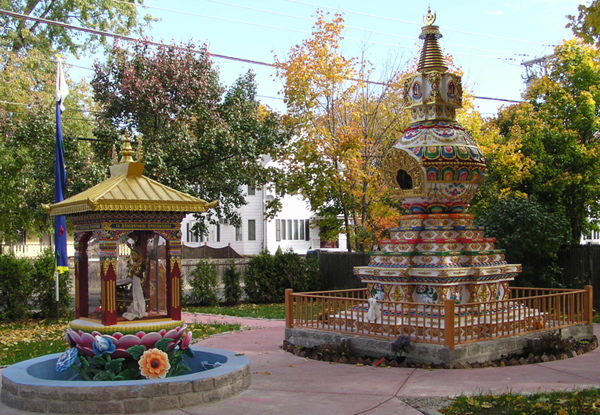Written by Alayna Barrios
History and Foundation of the Center

Kurukulla Center for Tibetan Buddhist Studies, located in Boston, Massachusetts, was founded in 1989 by Lama Zopa Rinpoche. Rinpoche studied meditation in Tibet from the age of ten with Domo Geshe Rinpoche after being recognized at the age of three as the reincarnation of Sherpa Nyingma yogi, Kunsang Yeshe, the Lawudo Lama. At the age of fourteen, he fled Tibet for Bhutan, and shortly thereafter to the Tibetan refugee camp at Buxa Duar in West Bengal, India, where he met Lama Yeshe, his future teacher. The two went on to found monasteries in Nepal. Lama Yeshe was the director of the Foundation for the Preservation of the Mahayana Tradition (FPMT), which the two lamas had founded in 1975. The two traveled the world with the aim of spreading Buddhism; Lama Zopa Rinpoche remained Lama Yeshe’s disciple until the latter’s death in 1984. Lama Zopa Rinpoche then took over the directorship of the FPMT. By the late 1980s, he was overseeing several Tibetan Buddhist centers in America, including the Milarepa Center, an FPMT affiliated center in Vermont. Its resident teacher, Geshe Losang Jampa suggested that he might be able to reach a larger audience if he were to move to Boston, to which Lama Rinpoche agreed, founding the Kurukulla Center. Geshe Losang Jampa died shortly thereafter, leading to the tenure of Geshe Tsulga from 1993 to his death in 2010. He was succeeded by his nephew Geshe Ngawang Tenley who continues to serve as resident teacher at Kurukulla today.
 Lama Zopa Rinpoche
Lama Zopa Rinpoche
While these the resident teachers at Kurukulla have all been Tibetan, the directors of the center have all been American, the longest reigning of which being Nicholas Ribush, an American student of Lama Yeshe and Lama Zopa Rinpoche, who co-founded Wisdom Publications, a publishing house affiliated with the FPMT. While Lama Zopa Rinpoche remained involved in the running of the Kurukulla Center, he did not reside in America but in Nepal from which he oversaw the more than one hundred monasteries and centers under the auspices of the FPMT. It is important to note that the Kurukulla Center is not a monastery, but an educational institution dedicated to the spread and maintenance of Mahayana Buddhism. Its constituency is mostly if not entirely American. It employs a translator in order to give its English-speaking students access to the teachings of Lama Yeshe. Since the goal of Lama Yeshe and Lama Zopa Rinpoche in traveling to the U.S. and elsewhere was to spread Buddhism to non-Buddhist audiences, this composition makes sense.
Lama Yeshe

Lama Yeshe was born in Tibet in 1935, studied at the Sera Monastic University in Lhasa for nearly twenty years, and eventually fled to India, to the refugee camp at Buxa Duar because of the Chinese occupation of Tibet, where he met his future chief disciple Lama Zopa Rinpoche. While in Tibet, he studied the perfection of wisdom (prajnaparamita), the middle way (madhyamaka) and logic. Whilst in India, he studied the rules of the vinaya and the classification system of abhidharma. He also studied with Tenzin Gyaltsen, the Khunu Lama, a renowned bodhisattva, and Geshe Rabten, a meditation practitioner with an especial aptitude for one-pointed focus. It was through Geshe Rabten that Lama Yeshe met Lama Zopa Rinpoche, who was one of Geshe Rabten’s students at the time. It was Geshe Rabten’s idea that Lama Zopa Rinpoche learn from Lama Yeshe, and since Rinpoche was a young student without guardians, his care and upbringing were given over entirely to Lama Yeshe, and the two remained together, guru and disciple, until Lama Yeshe’s death.
Venerable Geshe Tsulga

Geshe Tsulga was born Tsultrim Chophel in Tibet in 1939, and similar to Lama Yeshe, he entered the monastery as a young child and went on to study at the Sera Monastic University of Lhasa. Like both Lama Yeshe and Lama Zopa Rinpoche, he fled Tibet in 1959 due to the turmoil surrounding the Chinese occupation, and relocated to the refugee camp at Buxa Duar, where he crossed paths with the former two. He then went on to build the Sera Monastery in exile at Bylakuppe in south India, where he continued his Geshe studies. In 1992, Lama Zopa Rinpoche requested that he come to the U.S. and teach at three FPMT centers on the east coast: Milarepa in Vermont, Kadampa in North Carolina, and of course Kurukulla in Massachusetts. Lama Zopa Rinpoche asked him to teach in America for three years, but at the end of this time, Geshe Tsulga decided to settle in Boston and remain at Kurukulla Center as resident teacher. During his tenure at Kurukulla he wrote and published a history of the Sera Je Monastery where both he and Lama Yeshe studied, and the book How to Practice the Buddhadharma: A Lamp Illuminating the Path to Liberation. The latter is published in Tibetan and English for the convenience of the Kurukulla community, who are mostly English speaking as aforesaid. Geshe Tsulga died of liver cancer in 2010 and was followed in the office of resident teacher by his nephew Geshe Ngawang Tenley.
Venerable Geshe Ngawang Tenley

Ngawang Tenley entered the monastic community in 1990, and following in his uncle’s footsteps, continued his studies at Sera Monastic University of Lhasa [or, India?]. In 1998 he was ordained a full monk by the Dalai Lama himself. Over the course of his studies there he had received several teachings from the Dalai Lama and other highly regarded monastic masters. In 2008 he completed his Geshe degree, and in 2009 he began to teach at Kurukulla with his uncle. Upon the death of Geshe Tsulga, Lama Zopa Rinpoche recommended to the board of directors at Kurukulla that they fill the position of resident teacher with Geshe Ngawang Tenley. He was duly appointed and continues to serve as Kurukulla’s resident teacher today, working with center director Sean Gonzalez to further the goals of the center and the FPMT in Boston.
The Stupa Project

The Kurukulla Center has recently constructed a Kalachakra stupa on its grounds; it is called the Kalachakra Stupa for Peace at Kurukulla Center, and was completed in summer 2010. The project took a significant time to complete, though the stupa itself is not of massive proportions; a liberal estimate as to its dimensions would be about twenty feet in height and seven feet in diameter at its base. This is by no means an insignificant stature for a stupa, but it is nothing like, say, the Dhamek Stupa at Sarnath. In any case it was meticulously ritually constructed and constituted an ongoing part of the center’s mission for three years from 2007 to 2010.
The center’s website includes a section dedicated entirely to the stupa project, and within that a subsection on the history and benefits of stupas, respectively, as well as a section titled “what is a stupa”. The latter asserts that “there are three representations of the Buddha–body, speech, and mind…[a]nd stupas are the representation of the Buddha’s holy mind”. The body and speech representations are statues and the dharma, respectively. The section also explains how the structure of a stupa portrays the foundation of Buddhist practices (base and throne of stupa), the practices themselves (steps, vase, and harmika of stupa), and the result of the practices (pinnacle of stupa). The section dedicated to the history of stupas explains that the concept of relic-mounds predates Buddhism and that a shift in their significance took place when the Buddha requested that a stupa housing his relics be built at a crossroads to be used as a site of worship by passersby. The section on benefits of stupas includes a quote by Lama Zopa Rinpoche about how circumambulation of a stupa, even by accident, is highly auspicious; even insects and such that circumambulate a stupa are likely to be reborn well and eventually become awakened. None of the sections, however, address the idea that Buddha’s relics were divided and divided, and that many stupas ostensibly contain a portion of them. In any case the stupa at the Kurukulla Center contains no relics.
The Center’s Understanding of Buddhism:
The Kurukulla Center’s explanation of Buddhism states that the tradition had its origins in India 2500 years ago, and moved across the Himalayas into Tibet 1500 years ago, “where it became an inextricable part of the culture.” With the Chinese occupation of Tibet in 1949, the tradition finally began to expand beyond its South/East Asian homeland and into the rest of the world as Tibetans were forced out of their country and into exile around the world. The Kurukulla Center follows a strictly Tibetan mode of Buddhism, more or less ignoring the tradition’s inroads into China, Japan and Korea long before the Chinese occupation of Tibet. Furthermore, the center is dedicated to the preservation and spread of Mahayana Buddhism, following the teaching of the importance of altruism as regards the path to awakening and the key role of the bodhisattva. The center’s very purpose is to educate and help those on the path to awakening. The center’s explanation also states that “every person has the ability to reach their highest potential and that this is achieved by working with the mind”. There is a great focus on the power of meditation in the Kurukulla community, even if it is not a monastic one in the traditional sense; its goal is to educate people about Buddhism and set them on the path toward awakening, but it is unequipped to provide them the means to complete that journey to the fullest extent. Of course it is possible for the teachers there to take disciples, but there is no formal monastic order. One gets a sense that though the FPMT is dedicated to preserving and spreading Mahayana Buddhism worldwide, it is still very much centered in South Asia; Lama Zopa Rinpoche resides in Nepal at the Kopan Monastery he founded with Lama Yeshe, overseeing the FPMT from his native country. Thus if one began their journey at the Kurukulla Center and dedicated themselves to the FPMT, and wished to fulfill their monastic journey as a disciple of Lama Zopa Rinpoche himself, one would have to travel to Nepal. Nicholas Ribush, the former director of the Kurukulla Center, for example, studied at the Kopan Monastery with Lama Zopa Rinpoche before dedicating himself completely to the cause of the FPMT, and he is not even a monastic, but a lay practitioner.
Kurukulla Center for Tibetan Buddhist Studies. (2013). Retrieved November 9, 2020, from http://www.kurukulla.org/about-kurukulla-center-tibetan-buddhism.php
Lywa. (2018, December 13). Kyabje Lama Zopa Rinpoche. Retrieved November 9, 2020, from https://www.lamayeshe.com/teacher/kyabje-lama-zopa-rinpoche
The Official Homepage for Lama Zopa Rinpoche. (2020). Retrieved November 9, 2020, from https://fpmt.org/teachers/zopa/